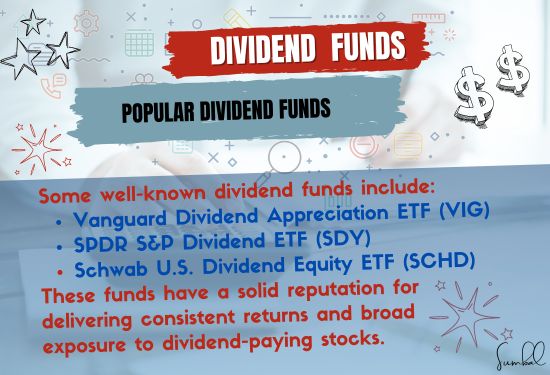Some investors desire stable income while accumulating capital, so investing in dividend funds may make great sense. Dividend funds invest only in stocks with a history of paying constant and regular dividends, which companies distribute profits among shareholders. Such funds appeal to investors who want regular income, ensure their financial security, and possibly earn more. This article examines dividend funds, why one should invest, and how to select the right fund.

What Are Dividend Funds?
Dividend funds involve corporate funds from various investors investing mainly in stocks that will provide dividends. These funds may include equities of recognized companies likely to pay out regular dividends or those with high dividend yields.
Typically, dividend funds fall into two categories:
- Equity Income Funds: Concentrate on shares with the highest dividend yields.
- Dividend Growth Funds: Buy stocks are likely to boost their dividend payments continually.
The dividends realized by the fund are paid to investors to generate sustainable income in both scenarios.

Benefits of Dividend Funds
1. Passive Income Stream
The consistent income provided by most dividend funds is one of their primary advantages. That is why these funds are popular among people who want to earn an additional income, such as retirees.
2. Stability of Finances
Dividend-paying businesses often have sound financial standing. Investing in such companies through dividend funds can offer a safer alternative to risky high-growth share investments.
3. Diversification
Dividend funds invest in different corporations within various industries, which makes them diversified. This lowers the risk of investing in individual equity, making the stock investment more secure.
4. Potential for Long-Term Growth
The opportunity to buy more shares and reinvest dividends can significantly increase the investment's worth. This ability will compound wealth while you have a steady income.
5. Hedge Against Inflation
Most companies that pay dividends increase payouts year after year. This growth will go a long way toward addressing inflation, which reduces overall purchasing power.
Risks of Dividend Funds
Despite their many benefits, dividend funds can carry certain risks.
- Market Volatility: Just like all equities, dividend funds are also vulnerable to changes in market situations.
- Concentration Risk: There are cases of dividend funds invested mainly in certain industries, such as utilities or consumer products, which may have little diversification.
- Dividend Cuts: Businesses may cut or stop paying dividends, which would impact the fund's earnings.

Choose the Right Dividend Fund
1. Assess Your Financial Goals
Consider your goals and how you hope to accomplish them. Which would you prefer: steady income, room for progress, or both?
2. Check Dividend Yield and Growth
Invest in funds with high dividend yields and stocks likely to pay high and growing dividends.
3. Analyze Fund Performance
Past results are not guaranteed for future performance. Consistency in returns is the key to an efficient managed fund.
4. Evaluate Fees
Understand the fund's expense ratio, as high fees can reduce the rate of return on your investments.
5. Diversification
Investing in diversified funds means funds that have their investments in several sectors.

Investment Strategies for High-Net-Worth Individuals

South Boston Average Rent Price Rapidly Approaching $3K

Fortifying Wealth: Isolation & Legacy for the Affluent

Before making a signed loan, you need to know

Understand the Inflation and Its Impact on Your Money

The Yield Curve as the Economic Prophecy of the Financial Market

How to Efficiently Manage Family Finances
